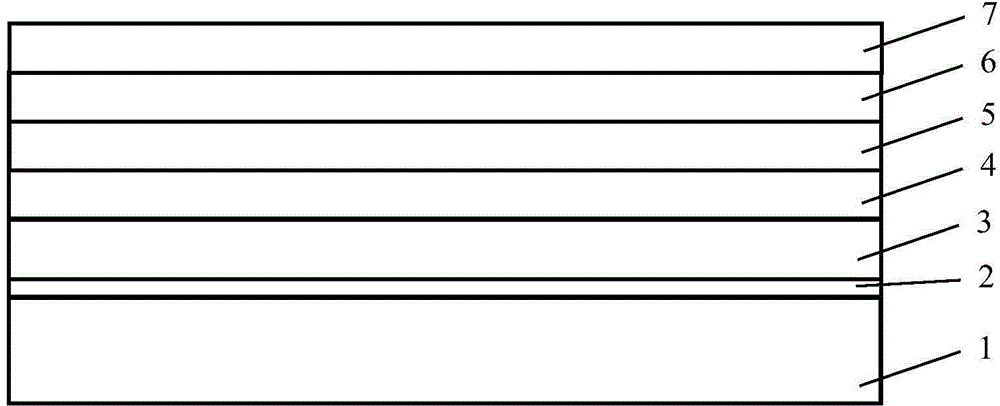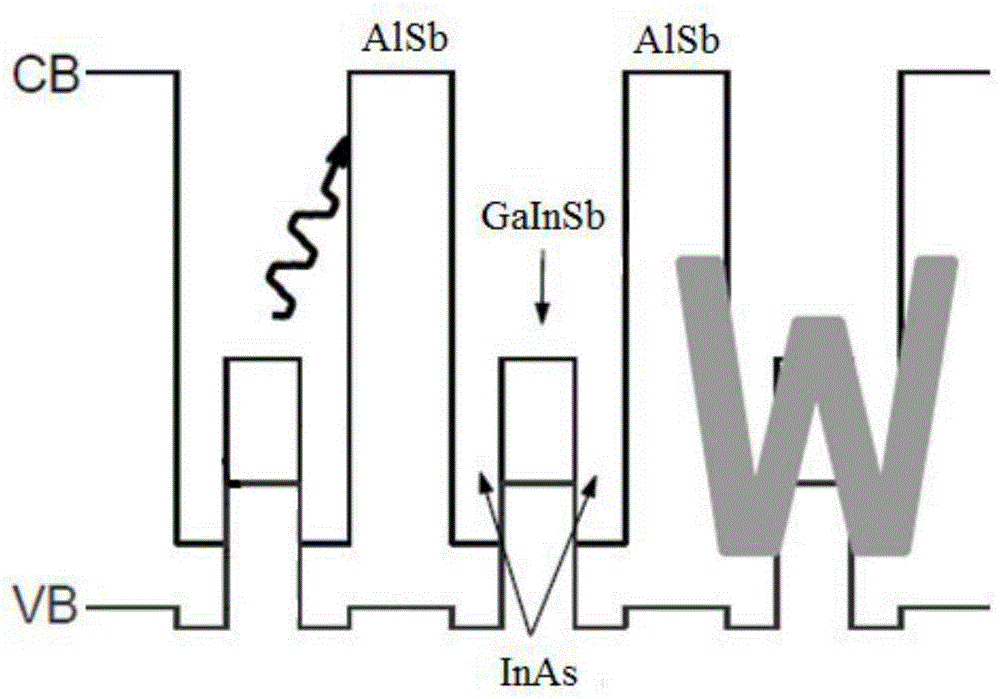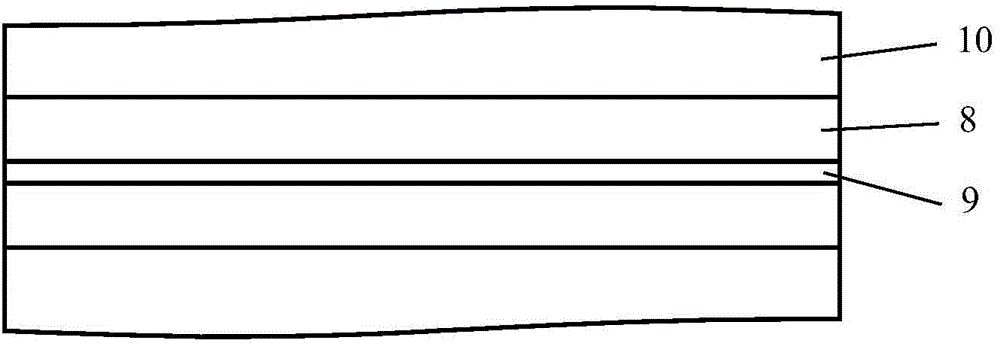W type antimony-based semiconductor laser with gradually varied Ga In proportion
A semiconductor and laser technology, applied in the field of W-type antimony-based semiconductor lasers, can solve the problems of low laser output power, inactive consumption of carriers, and low output power, so as to avoid inactive consumption, reduce non-radiative transitions, and reduce recombination centers Effect
- Summary
- Abstract
- Description
- Claims
- Application Information
AI Technical Summary
Problems solved by technology
Method used
Image
Examples
Embodiment 1
[0010] The W-type antimony-based semiconductor laser with gradually changing Ga In ratio of the present invention, from bottom to top, is GaSb substrate 1, GaSb buffer layer 2, P-type GaSb contact layer 3, P-type quantum well 4, intrinsic quantum well 5, N-type quantum well 6 and N-type InAs contact layer 7, such as figure 1 As shown, the P-type quantum well 4, the intrinsic quantum well 5, and the N-type quantum well 6 have a multi-period structure, and the structure of each single-period quantum well in the multi-period structure is composed of double InAs electron quantum wells 8 A sandwich structure sandwiching GaInSb hole quantum wells 9, the outer layer is a pair of AlSb alloy confinement layers 10, such as figure 2 , image 3 Shown; The GaInSb hole quantum well 9 is made of 3 layers of Ga 1-x In x Composition of Sb layer with 17ML thick Ga in the middle 0.8 In 0.2 Sb layer, level 1 is two 4ML thick Ga 0.9 In 0.1 Sb layer, Ga 1-x In x The total thickness of the...
Embodiment 2
[0012] The W-type antimony-based semiconductor laser with gradually changing Ga In ratio of the present invention, from bottom to top, is GaSb substrate 1, GaSb buffer layer 2, P-type GaSb contact layer 3, P-type quantum well 4, intrinsic quantum well 5, N-type quantum well 6 and N-type InAs contact layer 7, such as figure 1 As shown, the P-type quantum well 4, the intrinsic quantum well 5, and the N-type quantum well 6 have a multi-period structure, and the structure of each single-period quantum well in the multi-period structure is composed of double InAs electron quantum wells 8 A sandwich structure sandwiching GaInSb hole quantum wells 9, the outer layer is a pair of AlSb alloy confinement layers 10, such as figure 2 , image 3 Shown; The GaInSb hole quantum well 9 is made of 5 layers of Ga 1-x In x The Sb layer constitutes as Figure 4 shown, the middle is 17ML thick Ga 0.75 In 0.25 Sb layer, level 1 is two 2ML thick Ga 0.9 In 0.1 Sb layer, level 2 is two 2ML th...
Embodiment 3
[0014] The W-type antimony-based semiconductor laser with gradually changing Ga In ratio of the present invention, from bottom to top, is GaSb substrate 1, GaSb buffer layer 2, P-type GaSb contact layer 3, P-type quantum well 4, intrinsic quantum well 5, N-type quantum well 6 and N-type InAs contact layer 7, such as figure 1 As shown, the P-type quantum well 4, the intrinsic quantum well 5, and the N-type quantum well 6 have a multi-period structure, and the structure of each single-period quantum well in the multi-period structure is composed of double InAs electron quantum wells 8 A sandwich structure sandwiching GaInSb hole quantum wells 9, the outer layer is a pair of AlSb alloy confinement layers 10, such as figure 2 , image 3 Shown; The GaInSb hole quantum well 9 is made of 9 layers of Ga 1-x In x Composition of Sb layer with 17ML thick Ga in the middle 0.65 In 0.35 Sb layer, level 1 is two 1ML thick Ga 0.75 In 0.25 Sb layer, level 2 is two 1ML thick Ga 0.85 In...
PUM
 Login to View More
Login to View More Abstract
Description
Claims
Application Information
 Login to View More
Login to View More - R&D
- Intellectual Property
- Life Sciences
- Materials
- Tech Scout
- Unparalleled Data Quality
- Higher Quality Content
- 60% Fewer Hallucinations
Browse by: Latest US Patents, China's latest patents, Technical Efficacy Thesaurus, Application Domain, Technology Topic, Popular Technical Reports.
© 2025 PatSnap. All rights reserved.Legal|Privacy policy|Modern Slavery Act Transparency Statement|Sitemap|About US| Contact US: help@patsnap.com



